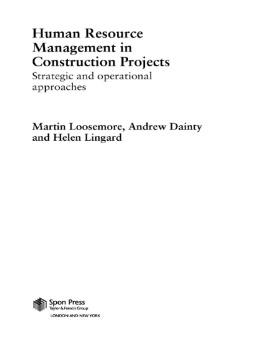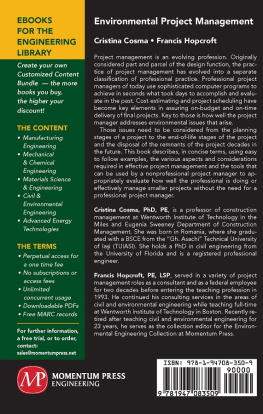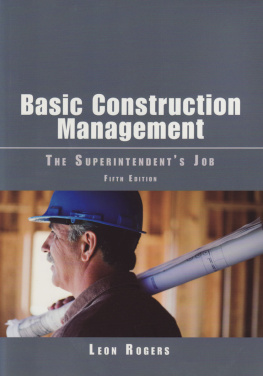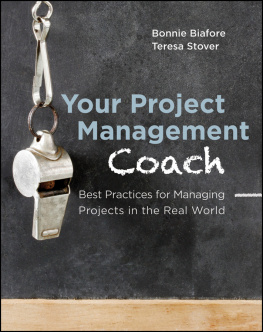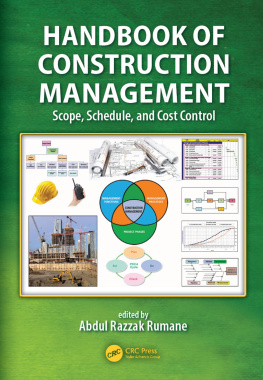Human Resource Management in Construction Projects
Although construction is one of the most labour-intensive industries, human resource management (HRM) issues are given inadequate attention. Furthermore, the focus of attention with regards to HRM has been as a centralised head-office function yet most problems and operational issues arise on projects. To help redress these problems this book examines both the strategic and operational aspects of managing human resources within the construction sector. The book is aimed at project managers and students of project management, who, until now, have been handed the responsibility for HRM without adequate knowledge or training.
The issues addressed in this book are internationally relevant, and are of fundamental concern to both students and practitioners involved in the management of construction projects. The text draws on the authors experience of working with a range of large construction companies in improving their HRM activities at both strategic and operational levels and is well illustrated with case studies of projects and organisations.
Dr Martin Loosemore is Professor of Construction Management and Associate Dean (Post Graduate Studies), Faculty of the Built Environment, University of New South Wales, Sydney, Australia. He has published numerous internationally refereed articles and books, has advised the Australian government on HR legislation and reform in the construction industry and is a director of a management consultancy which specialises in risk management.
Dr Andrew Dainty is a Lecturer in Construction Management, Department of Civil and Building Engineering at Loughborough University, UK. He has researched widely in the field of construction HRM on projects funded by the EPSRC, ESRC and European Union. He works closely with industry, and has undertaken a range of research, training and consultancy projects with construction companies of all sizes.
Dr Helen Lingard is a Lecturer in Construction Management at the University of Melbourne, Victoria, Australia. On completion of her PhD she worked for a British contracting firm, advising on the occupational health and safety issues arising on large civil engineering projects in Hong Kong. Dr Lingard moved to Australia in 1996. Since then she has undertaken extensive research into the impact of job demands in the construction industry on individual employees well-being.
First published 2003
by Spon Press
11 New Fetter Lane, London EC4P 4EE
Simultaneously published in the USA and Canada
by Spon Press
29 West 35th Street, New York, NY 10001
This edition published in the Taylor & Francis e-Library, 2003.
Spon Press is an imprint of the Taylor & Francis Group
2003 Martin Loosemore, Andrew Dainty and Helen Lingardexcept Figures 9.1 and 9.2 Crown copyright 2002/HMSO
All rights reserved. No part of this book may be reprinted or reproduced or utilised in any form or by any electronic, mechanical, or other means, now known or hereafter invented, including photocopying and recording, or in any information storage or retrieval system, without permission in writing from the publishers.
British Library Cataloguing in Publication Data
A catalogue record for this book is available from the British Library
Library of Congress Cataloging in Publication Data
Loosemore, Martin, 1962
Human resource management in construction projects : strategic and operational approaches / Martin Loosemore, Andrew Dainty & Helen Lingard.
1. Construction industryPersonnel management. I. Dainty,Andrew. II. Lingard, Helen. III. Title.
HD9715.A2 .L656 2002
624 '.068 '3dc21 2002010918
ISBN 0-203-41788-7 Master e-book ISBN
ISBN 0-203-41937-5 (Adobe eReader Format)
ISBN 0-415-26163-5 (hbk)
ISBN 0-415-26164-3 (pbk)
Illustrations
Tables
Key differences between HRM and personnel management
Soft HRM rhetoric hiding hard HRM reality in the construction industry
HR strategy formulation matrix
Briers to the changes required for empowerment within the UK construction sector
Opportunity and diversity
Organisation, person and job sources of human error
Figures
The Michigan Model of HRM
The Harvard Model of HRM
The Warwick Model of strategic change and HRM
The Flexible Firm
Greiners model of organisational growth through evolution and revolution
Line and staff organisational structure
Example of a matrix organisational structure
The personnel function
The relationship between task and technology
The SHRM cycle
A model of the competing pressures and interdependent functions involved in the resourcing of project teams
Economic analysis of OHS
Key elements of successful health and safety management
Kolbs Learning Cycle
Training transfer model
Preface
The construction industry is one of the largest global employment sectors, providing work for a significant proportion of the labour market and accounting for a significant share of the world gross domestic product (GDP). The industry also represents one of the most risky, complex and dynamic industrial environments. A construction project relies on skilled manual labour supported by a management framework, which has to coordinate many professional, construction and supplier organisations whose sporadic involvement will change through the course of the project. The fragmentation and dynamism of this process and the need to integrate a wide range of occupational cultures renders construction one of the most complex project-based industries in which to apply good human resource management (HRM) practices.
Organisational behaviour and management texts abound which explain the central importance of the HRM function to organisational performance. However, few have considered the specific context and challenges that project-based industries present. Moreover, very few texts have sought to capture effective approaches to the HRM function within the construction sector, or to examine how these activities could be adapted and implemented in a way which improves the performance and job satisfaction of the industrys workforce. In this book we aim to address this shortfall by providing an informative exploration into how modern construction organisations manage the various aspects of HRM. As well as holding up a mirror to current practice, we also cast a critical eye over current approaches to managing people in the industry. We have attempted to identify new and alternative strategies for managing people that enable managers and organisations to survive the increasingly competitive and volatile construction industry labour market.
We would like to think that this book is different to existing texts on HRM in the construction industry. First, this book focuses on the project level and is designed to assist construction project managers to manage the HRM function effectively. In construction companies responsibility for HRM is almost entirely devolved to project managers, few of whom have any formal training in this area. Consequently most see it as a nuisance and as a secondary maintenance function which does not contribute directly to the attainment of project objectives. It is not surprising, therefore, that the construction industry has a poor and sometimes appalling record and public image in many areas of HRM. This leads us to the second unique feature of this book, which is the link it draws between HRM and organisational performance. We see this as the key to positioning HRM at the centre of the construction debate and thereby to releasing the significant untapped productive potential of the industrys workforce. If we can persuade project managers of the strong link that exists between HRM performance and project performance we will have succeeded in our aim. We believe that HRM is the forgotten reform in the construction industry and that recognition of its importance is long overdue. Another feature of this book is the array of subjects tackled. Many HRM books predictably follow the standard HRM cycle of recruitment, selection, development, orientation, induction, training, appraisal, compensation, promotion, demotion and termination. While we do not neglect these important issues, we restrict them to one chapter and thereby release the remaining eleven chapters to consider, in detail, issues of contemporary interest such as equality and diversity, empowerment and employee participation, occupational health and safety, worklife balance and industrial relations, etc. These topics are enlivened by numerous case studies which provide practical examples of best practice around the world particularly in Asia, Australia and the UK. As the construction industry becomes truly global, the need to understand and contrast practices, performance and standards in different countries will become increasingly important to managers.

